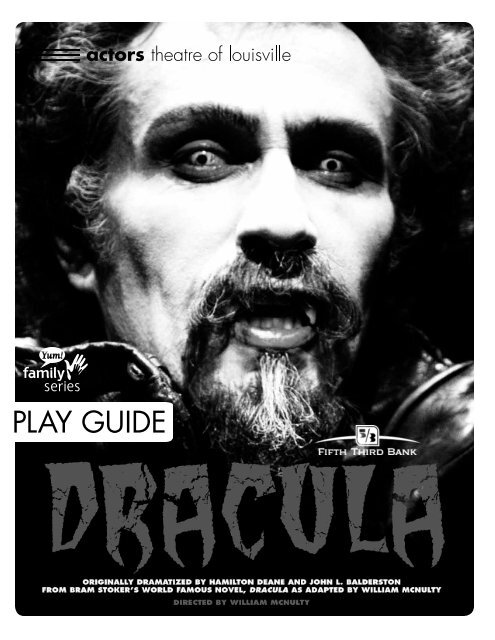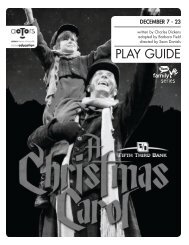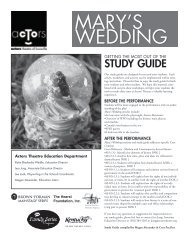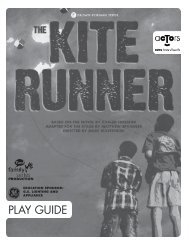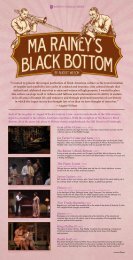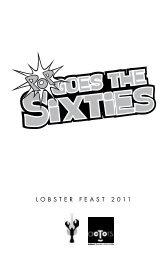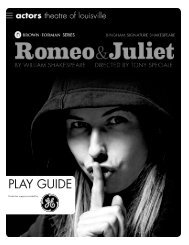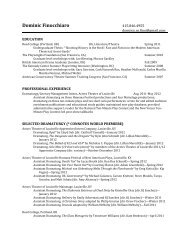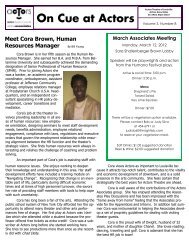Dracula Play Guide - Actors Theatre of Louisville
Dracula Play Guide - Actors Theatre of Louisville
Dracula Play Guide - Actors Theatre of Louisville
You also want an ePaper? Increase the reach of your titles
YUMPU automatically turns print PDFs into web optimized ePapers that Google loves.
PLAY GUIDE
About the<br />
DRACULA<br />
<strong>Play</strong> <strong>Guide</strong><br />
This play guide is a standards-based<br />
resource designed to enhance your theatre<br />
experience. Its goal is tw<strong>of</strong>old: to nurture<br />
the teaching and learning <strong>of</strong> theatre arts<br />
and to encourage essential questions that<br />
lead to enduring understandings <strong>of</strong> the<br />
play’s meaning and relevance. Inside you<br />
will find history/contextual information,<br />
vocabulary and worksheets that lay<br />
the groundwork <strong>of</strong> the story and build<br />
anticipation for the performance. Oral<br />
discussion and writing prompts encourage<br />
your students to reflect upon their<br />
impressions and to analyze and relate key<br />
ideas to their personal experiences and the<br />
world around them. These can easily be<br />
adapted to fit most writing objectives. The<br />
Bridgework connects theatre elements with<br />
ideas for drama activities in the classroom<br />
as well as integrated curriculum. We<br />
encourage you to adapt and extend the<br />
material in any way to best fit the needs <strong>of</strong><br />
your community <strong>of</strong> learners. Please feel<br />
free to make copies <strong>of</strong> this guide, or you<br />
may download it from our website: www.<br />
actorstheatre.org. We hope this material,<br />
combined with our pre-show workshops,<br />
will give you the tools to make your time<br />
at <strong>Actors</strong> <strong>Theatre</strong> a valuable learning<br />
experience.<br />
<strong>Dracula</strong> student matinees and play guides<br />
provide evidence that meet your program<br />
review characteristics and address specific<br />
educational objectives:<br />
• Students will identify or describe the<br />
use <strong>of</strong> elements <strong>of</strong> drama in dramatic<br />
works.<br />
• Students will analyze how time,<br />
place and ideas are reflected in<br />
drama/theatre<br />
• Students will explain how<br />
drama/theatre fufills a variety <strong>of</strong><br />
purposes<br />
Table <strong>of</strong> contents<br />
3 Synopsis, Cast <strong>of</strong> Characters<br />
4 Vlad the Impaler: The Real <strong>Dracula</strong><br />
5 Bram Stoker: The Man Behind the Monster<br />
6-7 Bloodlines: Vampire History<br />
8 Vampire Survival Kit<br />
9 <strong>Theatre</strong>-in-the-Round<br />
10-11 Bridgework<br />
12 Discussion Questions and Writing Portfolio<br />
<strong>Actors</strong> <strong>Theatre</strong> Education<br />
Steven Rahe, Director <strong>of</strong> Education<br />
Jacob Stoebel, Associate Director <strong>of</strong> Education<br />
Jane B. Jones, Education Associate<br />
Liz Fentress, Resident Teaching Artist<br />
Keith McGill, Resident Teaching Artist<br />
Gabriel Garcia, Education Intern/Teaching Artist<br />
LeShawn Holcomb, Education Intern/Teaching Artist<br />
Lori Pitts, Education Intern/Teaching Artist<br />
Christina Shackelford, Education Intern/Teaching Artist<br />
<strong>Play</strong> <strong>Guide</strong> compiled by Aurelia Clunie, Sarah Lunnie,<br />
Jeffrey Mosser, Rosie Chevalier, Steven Rahe, Jacob Stoebel,<br />
Jess Jung and Katie Blackerby Weible.<br />
If you have any questions or suggestions<br />
regarding our play guides, please contact<br />
Steven Rahe, Director <strong>of</strong> Education, at<br />
(502) 584-1265 ext. 3045<br />
Fund for the Arts<br />
Members Agency
Cast <strong>of</strong><br />
Characters<br />
DR. SEWARD<br />
Head Doctor at the asylum. In mourning<br />
over the death <strong>of</strong> his fiancee Mina.<br />
COUNT DRACULA<br />
Seward’s new neighbor; recently moved<br />
from Transylvania.<br />
PROFESSOR ABRAM<br />
VAN HELSING<br />
Old friend <strong>of</strong> Seward; comes to help Lucy.<br />
MINA: LOVE OF SEWARD<br />
Recently died <strong>of</strong> a mysterious illness<br />
involving a loss <strong>of</strong> blood.<br />
LUCY: MINA’S FRIEND<br />
Displaying the same troubling symptoms<br />
as her friend Mina.<br />
JONATHAN HARKER<br />
Lucy’s fiancé; missing after a trip to<br />
Transylvania.<br />
Synopsis<br />
Trouble is brewing when the curtain rises on William McNulty’s new adaptation <strong>of</strong><br />
<strong>Dracula</strong>. Dr. Abram Van Helsing has arrived at the estate <strong>of</strong> his old friend, Dr. Seward,<br />
who is desperate for help. Seward’s beloved Mina has recently died <strong>of</strong> a sudden and<br />
mysterious illness. Her horrific symptoms have proved baffling to the bereaved doctor:<br />
sudden loss <strong>of</strong> blood, bouts <strong>of</strong> sleepwalking in the cemetery, and strange puncture wounds<br />
on the neck. To make matters worse, Mina’s friend, Lucy, has begun to display the same<br />
symptoms! Seward hopes that Van Helsing, a noted expert in exotic medicine, will be able<br />
to uncover the cause <strong>of</strong> Lucy’s illness, and save her before it’s too late.<br />
Meanwhile, Count <strong>Dracula</strong>, a strange and imposing man from Transylvania, has taken up<br />
residence in nearby Carfax Abbey. And Lucy’s fiancé, Jonathan Harker, has mysteriously<br />
vanished. A solicitor who helped arrange the sale <strong>of</strong> the Abbey, Harker traveled to<br />
Transylvania a few months ago to finalize business matters with the Count… and never<br />
returned home.<br />
At Seward’s estate, Renfield, a mental patient, is becoming more wild and unruly by the<br />
day, almost as though he were possessed. Lucy’s symptoms continue to grow worse. And<br />
how to account for the sudden onslaught <strong>of</strong> howls, coming by night from up the hill?<br />
RENFIELD<br />
Psychiatric patient who seems to know a bit<br />
too much about what is going on.<br />
miss sullivan<br />
Dr. Seward’s assistant.<br />
MR. Briggs<br />
Dr. Seward’s orderly. Responsible for<br />
maintaining peace among the patients.<br />
Setting<br />
The Victorian Era.<br />
Dr. Seward’s sanatorium and<br />
environs in Purley, England.<br />
Later in Transylvania.<br />
Van Helsing believes the problem they face is a grave one: “My diagnosis is there is no<br />
disease! The symptoms are real. But the cause is not internal.” He believes that Mina, and<br />
now Lucy, have suffered at the hands <strong>of</strong> a vampire. To save Lucy’s life, they will have to<br />
uncover the identity <strong>of</strong> the life-sucking demon, and destroy him. But the endeavor is a<br />
dangerous one. A vampire is a fearsome enemy, and the risks are greater than death. Should<br />
the doctors perish in their pursuit, they too will become vampires, spending an eternity<br />
preying upon the bodies and souls <strong>of</strong> those whom once they dearly loved. Will Seward and<br />
Van Helsing find the vampire and save Lucy’s life? Or is the monster about to claim yet<br />
another victim?<br />
3
Vlad the impaler<br />
THE REAL dracula<br />
Vlad <strong>Dracula</strong>, later<br />
named Vlad the Impaler<br />
after his favorite form <strong>of</strong><br />
torture, was a 15 th century<br />
prince who ruled with an<br />
iron fist. This infamous ruler<br />
controlled his subjects with<br />
such violence that he is now<br />
referred to as the bloodiest<br />
ruler in history.<br />
Vlad was born in Transylvania in<br />
1430 or 1431. His father, the warrior<br />
Vlad Dracul, was a member <strong>of</strong> a secret<br />
society <strong>of</strong> knights called the Order <strong>of</strong><br />
the Dragon. This society was formed<br />
to fight and defeat the Turks, as well<br />
as secure the throne <strong>of</strong> Wallachia (a<br />
town located in present-day Romania).<br />
The Order brothers dressed in long<br />
green capes except on special occasions<br />
in which they would wear long<br />
black capes and drape gold dragon<br />
medallions around their necks.<br />
Young Vlad was nicknamed <strong>Dracula</strong><br />
after his father. In Romanian, Dracul<br />
translates to ‘dragon’ or ‘devil,’ and<br />
the ‘a’ stands for ‘son <strong>of</strong>.’ So <strong>Dracula</strong><br />
literally translates to ‘son <strong>of</strong> the dragon’<br />
or ‘son <strong>of</strong> the devil.’<br />
In 1444 Dracul was traveling with<br />
<strong>Dracula</strong> and his youngest son across<br />
the Danube River when they were<br />
captured by the Turks. <strong>Dracula</strong> was<br />
imprisoned for four years. These years<br />
are thought to be the beginning <strong>of</strong><br />
Vlad <strong>Dracula</strong>’s violent nature. It wasn’t<br />
long before Dracul was assassinated<br />
and <strong>Dracula</strong>’s brother was buried<br />
alive by the ruler <strong>of</strong> Hungary, Jamos<br />
Hunyadi. Fearful for his life, <strong>Dracula</strong><br />
joined Hunyadi who taught him<br />
cunning and severe military tactics that<br />
would soon secure <strong>Dracula</strong> the throne<br />
<strong>of</strong> Wallachia.<br />
As Prince, Vlad <strong>Dracula</strong> continued to<br />
battle the Turks. Those taken hostage<br />
were impaled (a large pole was driven<br />
through their body). But it was not<br />
only <strong>Dracula</strong>’s enemies who suffered.<br />
Many townspeople were also subject to<br />
his wrath.<br />
One story tells <strong>of</strong> <strong>Dracula</strong> noticing a<br />
peasant man who was wearing a shirt that<br />
was too short. When <strong>Dracula</strong> asked the<br />
man’s wife why the man was improperly<br />
dressed, she said she was too busy cooking<br />
and cleaning to sew. She was immediately<br />
impaled. Graciously, <strong>Dracula</strong> chose a new<br />
wife for the man. He made sure to show the<br />
new wife what had happened to the old so<br />
that she would not make the same mistake.<br />
<strong>Dracula</strong> died in battle in 1476. He was<br />
promptly decapitated by order <strong>of</strong> the<br />
Turkish sultan. His head was then sent to<br />
Woodcut print <strong>of</strong> Vlad surrounded by his victims<br />
the sultan who displayed it, fittingly, on a<br />
stake for all to see.<br />
Although gone, rumors <strong>of</strong> Vlad <strong>Dracula</strong><br />
and his relentless temper spread throughout<br />
Europe. Stories <strong>of</strong> his villainy were<br />
published, read, and reread, and it was these<br />
stories that led Bram Stoker in creating the<br />
infamous Count <strong>Dracula</strong> we know today.<br />
4
BRAM Stoker<br />
the man behind the monster<br />
Bram Stoker always liked scary<br />
stories. He was born near Dublin, Ireland<br />
on November 8, 1847, but was sick during<br />
most <strong>of</strong> his childhood. He read in bed a lot<br />
and liked to listen to the stories his mother<br />
Charlotte told. Her stories were sometimes<br />
creepy, like the ones about victims <strong>of</strong> the<br />
1832 Irish cholera epidemic who were<br />
buried before they were entirely dead. As<br />
he grew up, Stoker got stronger and even<br />
played sports and joined clubs when he<br />
went to Trinity College. He still liked to<br />
read strange stories like the influential 1871<br />
vampire novel Carmilla by Le Fanu. Stoker<br />
tried writing his own horror story, “The<br />
Chain <strong>of</strong> Destiny,” which appeared in a<br />
magazine in 1875. The Duties <strong>of</strong> Clerks <strong>of</strong><br />
Petty Sessions in Ireland didn’t raise hairs on<br />
the backs <strong>of</strong> readers’ necks, but was a really<br />
useful resource for other clerks.<br />
Stoker first worked for the<br />
Irish government, but loved putting his<br />
imagination to use and loved the theatre.<br />
In college he saw The Rivals, starring Henry<br />
Irving, and was blown away. The show<br />
inspired Stoker to write a theatre review<br />
column for the newspaper the Dublin Mail.<br />
Years later, he wrote a good review about<br />
Henry Irving’s performance in Hamlet, and<br />
the actor invited him backstage. The two<br />
began a close friendship and Stoker moved<br />
to London with his young wife to become<br />
the Business Manager <strong>of</strong> Irving’s Lyceum<br />
<strong>Theatre</strong>.<br />
Stoker continued writing<br />
fiction while working at the Lyceum. He<br />
published a collection <strong>of</strong> scary children’s<br />
stories called Under the Sunsetin 1881.<br />
In the 1890’s, he wrote some romantic<br />
novels, but was working on his vampire<br />
thriller. Stoker painstakingly researched<br />
places, superstitions, and myths while<br />
writing <strong>Dracula</strong>. He visited many <strong>of</strong> the<br />
locations he wrote about in the book,<br />
including the Regent’s Park Zoo where<br />
he observed animals that would appear in<br />
<strong>Dracula</strong>. Stoker stayed up nights discussing<br />
dark matters with his friends. Diary<br />
entries, letters, newspaper articles, verbal<br />
testimonies and other first hand accounts<br />
form Stoker’s frightening narrative. He<br />
creatively used many fictional sources to<br />
make the story seem more authentic. When<br />
<strong>Dracula</strong> finally reached readers in 1897,<br />
reviewers generally praised it.<br />
They enjoyed its “ingenious and gruesome<br />
details” and how exciting it was for readers.<br />
Stoker had successfully written a thrilling<br />
horror novel that would terrify generations.<br />
He wrote other novels before he died in<br />
1912, but none could compete with the<br />
legend he created in <strong>Dracula</strong>.<br />
Bram Stoker<br />
5
Bloodlines:<br />
taking a bite out <strong>of</strong> vampire history<br />
We’ve always had a dark fascination with vampires. From<br />
the earliest accounts <strong>of</strong> these monsters to today’s popular<br />
interpretations, vampires continue to capture our collective<br />
imagination. The image <strong>of</strong> the thirsty undead has permeated<br />
popular culture in everything from books to television series,<br />
graphic novels to feature films. Whether evil bloodsuckers or nice<br />
guys who just happen to have fangs, vampires come in all shapes<br />
and sizes. Here’s a look at how some <strong>of</strong> these stories emerged, and<br />
how they have evolved over time.<br />
Timeline by Rosie Chevalier<br />
1897 Bram Stoker writes <strong>Dracula</strong>.<br />
The Irishman, a sometime theatre critic/<br />
manager, crafts the novel as a series <strong>of</strong><br />
journal entries, correspondence between<br />
characters, and newspaper clippings.<br />
Though it’s initially slow to sell, it meets<br />
high critical praise and ultimately becomes<br />
one <strong>of</strong> the greatest classics <strong>of</strong> all time.<br />
1400s The Transylvanian-born<br />
ruler <strong>of</strong> Wallachia, Vlad III (<strong>of</strong>ten called<br />
“Vlad the Impaler,” “Vlad <strong>Dracula</strong>,” or<br />
just “<strong>Dracula</strong>”), sadistically kills tens <strong>of</strong><br />
thousands <strong>of</strong> people who have <strong>of</strong>fended<br />
him in any number <strong>of</strong> ways. His preferred<br />
method is impalement, and so the<br />
vampire rumor mill starts a-turning; Vlad<br />
effectively becomes the prototype for the<br />
most famous vampire <strong>of</strong> all time.<br />
1600s Thought to have tortured and<br />
murdered hundreds <strong>of</strong> young women in<br />
her later years, Erzsébet Báthory is also<br />
rumored to have feasted on their blood. In<br />
all likelihood, the Hungarian countess is<br />
probably less vampire, more serial killer.<br />
1990s The ‘90s see vampires brought to film in record numbers,<br />
and in a variety <strong>of</strong> styles. This decade brings us Innocent Blood,<br />
Interview with the Vampire, From Dusk Till Dawn, and Blade, among<br />
others. We also get two new takes on the <strong>Dracula</strong> story: Francis Ford<br />
Coppola casts Gary Oldman as a chilling version <strong>of</strong> the Count in<br />
Bram Stoker’s <strong>Dracula</strong>, and Mel Brooks gives us a go<strong>of</strong>ier take with<br />
Leslie Nielsen in <strong>Dracula</strong>: Dead and Loving It.<br />
1997 Buffy: The Vampire Slayer, the<br />
popular spin-<strong>of</strong>f series launched by the<br />
1992 film, chronicles the adventures<br />
<strong>of</strong> Buffy Summers, her gang <strong>of</strong> outcast<br />
friends, and their sunny California high<br />
school perched on the mouth <strong>of</strong> hell. The<br />
age <strong>of</strong> the relatable vampire story has<br />
<strong>of</strong>ficially arrived, complete with teenage<br />
angst and snappy dialogue. Angel, the<br />
Slayer’s tormented vampire love interest<br />
(who later gets his own series), is among the<br />
new breed <strong>of</strong> kinder, gentler bloodsuckers.<br />
2005 Maybe you’ve heard <strong>of</strong> Twilight?<br />
Stephenie Meyer’s quartet <strong>of</strong> novels has<br />
sold over 200 million copies so far, and<br />
inspired 4 successful motion pictures, with<br />
another on the way. Part vampire story,<br />
part heart-pounding teen romance, Meyer<br />
further explores the idea <strong>of</strong> vampires with<br />
consciences.<br />
1970s-1980s Vampires are nearly<br />
ubiquitous, popping up in everything from<br />
blaxploitation to campy cult films. Several<br />
more serious treatments are Stephen King’s<br />
novel Salem’s Lot and the next two <strong>Dracula</strong><br />
films, one with Jack Palance and the other<br />
starring Frank Langella (another stage<br />
<strong>Dracula</strong>) and Sir Laurence Olivier.<br />
2012<br />
In the virtual world, anyone with a Facebook<br />
account can become a vampire and infect their<br />
Facebook friends by clicking a button that<br />
says “Bite These Chumps.” It seems that, like<br />
Facebook, vampires aren’t going anywhere<br />
anytime soon.<br />
1972<br />
Count von Count<br />
joins the cast<br />
<strong>of</strong> Sesame Street<br />
on PBS. This<br />
polyester Count<br />
doesn’t bite<br />
people, sleep in<br />
a c<strong>of</strong>fin, or cause<br />
trouble <strong>of</strong> any<br />
kind. He counts.<br />
Meet the world’s<br />
first cuddly<br />
vampire. Mwah<br />
ha ha! Thunder<br />
clap.<br />
6
1922 F.W. Murnau’s horror classic<br />
Nosferatu is the first time <strong>Dracula</strong> sees<br />
the big screen…just don’t call him<br />
<strong>Dracula</strong>. Unable to obtain the rights to<br />
the story from Stoker’s estate, Murnau<br />
isn’t allowed to use the name or even the<br />
word “vampire.” But Max Schreck’s spooky<br />
monster still manages to horrify and thrill<br />
film audiences.<br />
1966<br />
The twisted romance <strong>of</strong> the seduction,<br />
the pathos and tragedy <strong>of</strong> the attack: is it<br />
any wonder that the next destination for<br />
vampires is the world <strong>of</strong> soap operas? Dark<br />
Shadows brings good old-fashioned gothic<br />
horror to daytime television.<br />
1958 Hammer<br />
Film Company’s<br />
remake stars<br />
a terrifying<br />
Christopher Lee<br />
in the title role.<br />
1924 <strong>Dracula</strong><br />
is adapted for<br />
the stage by<br />
Hamilton Deane<br />
and premieres in<br />
London. Three<br />
years later, the<br />
adaptation is<br />
revised by John<br />
L. Balderston for<br />
the New York<br />
production.<br />
1931 The first authorized <strong>Dracula</strong><br />
film is worth the wait: based on the stage<br />
adaptation, it stars Hungarian actor Bela<br />
Lugosi, reprising his role from the 1927<br />
Broadway production, as an unforgettable<br />
Count.<br />
Zachary Palamara, <strong>Dracula</strong> (2006)<br />
7
vampire survival kit<br />
everything you need to know for your<br />
encounter with the undead<br />
The vampire is an ancient and mythic figure. There’s a good chance you’ve heard the <strong>Dracula</strong> tale,<br />
made famous by Bram Stoker’s novel and by countless classic film remakes based on his book.<br />
But less widely known, perhaps, is the fact that countries all over the world have their very own<br />
vampire stories—each one stranger and more frightening than the next!<br />
What is a vampire?<br />
Stories vary from country to country,<br />
but all <strong>of</strong> the dark tales share certain things in common:<br />
• A vampire is neither human, nor dead, but rather undead: a being from<br />
beyond the grave, who destroys life in order to continue its own unnatural existence.<br />
• In most cultures, vampires are said to feed on human blood in order to<br />
sustain themselves—usually with a quick bite to the neck!<br />
Where do vampires come from?<br />
Depending on who you ask, you’ll find many different stories about where a vampire comes<br />
from. But many cultures believe that the arrival <strong>of</strong> a vampire in town means a social taboo<br />
has been broken.<br />
• In Macedonia, people once believed vampires (known as vrykolakas), turned<br />
up when someone didn’t respect local burial rituals, or because <strong>of</strong> the death<br />
<strong>of</strong> an unbaptized child.<br />
• In Portugal and Russia, people attributed the arrival <strong>of</strong> a vampire to the practice<br />
<strong>of</strong> witchcraft.<br />
How do you kill a vampire?<br />
There are lots <strong>of</strong> stories about where a vampire comes from, but even more opinions on how<br />
to do away with him. Wreathes <strong>of</strong> garlic around the neck, holy water, and stakes to the<br />
heart are well-known vampire remedies, but there are others you may not be familiar with.<br />
Here’s what you need to know if you’re expecting a late-night encounter:<br />
• To kill a vampire in Albania, Romania, and Russia, you can stab it in the<br />
heart with a knife and cut its throat. (Please be careful: in Russia there’s no<br />
room for error. If you strike more than once, it will come back to life.)<br />
• In Bavaria and Russia, cut <strong>of</strong>f his head! Ditto for Greece and Crete—<br />
but afterwards, you’ll have to boil it in vinegar.<br />
• In Macedonia, Hungary and Serbia, drive a nail into his head, neck or navel.<br />
• In Ireland, place stones on top <strong>of</strong> his grave to prevent him from escaping.<br />
• In Poland, bury the vampire face downward. He’ll become confused, and<br />
spend eternity digging for freedom in the wrong direction.<br />
8
theatre-in-the-round<br />
T<br />
Bingham <strong>Theatre</strong><br />
<strong>Theatre</strong>-in-the-round, or an arena stage, is a space in which the audience surrounds the playing<br />
area. The stage is usually a simple shape such as a circle, square, or triangle, with the audience rising<br />
up from all sides (think <strong>of</strong> a bowl: the bottom is the stage and the sides are the audience). The first<br />
pr<strong>of</strong>essional American theatre-in-the-round company, <strong>Theatre</strong> ’47 in Dallas, was established in 1947.<br />
You will witness a theatre-in-the-round production when seeing <strong>Dracula</strong> in <strong>Actors</strong> <strong>Theatre</strong> <strong>of</strong><br />
<strong>Louisville</strong>’s Bingham <strong>Theatre</strong>. The cast and crew use the round space to add extra fright to the<br />
production. So be careful! No matter where you sit, there might be something lurking…<br />
Can you name the other two types <strong>of</strong> theatre stages? What does each look like?<br />
9
Bridgework<br />
building connections between stage and classroom<br />
The following exercises combine creative drama, theatre concepts and core content to connect the theatre experience with drama activities in your classroom.<br />
By exploring drama as a mode <strong>of</strong> learning, students strengthen skills for creative problem solving, imagination and critical thinking.<br />
AT YOUR DESK Activities<br />
Theme Lines<br />
Choose a character’s line(s) from the script that reflect an important<br />
theme <strong>of</strong> the play. Write a brief thought <strong>of</strong> your own that expresses<br />
that theme. What does it mean to you? Read both the script line<br />
and your own thought aloud to the class.<br />
Journal Entry<br />
Stoker begins his novel, <strong>Dracula</strong>, with a journal entry <strong>of</strong> John<br />
Harker’s:<br />
3 May. Bistritz.—Left Munich at 8:35 P.M., on 1st May, arriving at<br />
Vienna early morning; should have arrived at 6:46, but train was an<br />
hour late. Buda-Pesth seems a wonderful place from the glimpse which<br />
I got <strong>of</strong> it from the train and the little I could walk through the streets.<br />
I feared to go very far from the station, as we had arrived late and<br />
would start as near the correct time as possible. The impression I got<br />
was that we were leaving the West and entering the East…<br />
Think about which characters might be the protagonist and the<br />
antagonist in the play. Write a journal entry in the voice <strong>of</strong> either<br />
character (or both). Explain his objective or goal and describe<br />
reasons for wanting it (motivation). What actions does this<br />
character take to achieve his goal? Remember to justify every action<br />
and thought <strong>of</strong> your character.<br />
Create a Sound Design<br />
The technical element <strong>of</strong> sound creates mood and places us in a<br />
specific time and place. Assume the role <strong>of</strong> sound designer for your<br />
own contemporary production <strong>of</strong> DRACULA. Make a list <strong>of</strong> sound<br />
effects and music you would use.<br />
ON YOUR FEET Activities<br />
Warm-up<br />
Sound/Motion Circle – <strong>Play</strong>ers in circle. First person starts a<br />
“scary” sound and motion around circle. Person to his/her right<br />
imitates sound/motion and passes it to next person on right. When<br />
sound/motion makes it all the way around, person standing to left<br />
<strong>of</strong> first person starts new sound/motion. Repeat until all players<br />
have had a turn.<br />
Get Your Freak On<br />
When auditioning for <strong>Dracula</strong>, some <strong>of</strong> the actors are asked to<br />
do their best creepy moves. Ask your students to walk around<br />
the room. Tell them you are going to play different pieces <strong>of</strong><br />
music. When they hear the music, ask them to change their body<br />
movement. Ask them to visualize a character that fits the tone <strong>of</strong><br />
the music and to embody that character. Students should focus only<br />
on nonverbal expression.<br />
10<br />
Use several different types <strong>of</strong> music: classical, spooky Halloween,<br />
jazz, etc. Be sure to leave time for reflection. What did it feel like?<br />
Were some pieces <strong>of</strong> music easier than others? Why? How can<br />
music inform a character? How can music add to the tone <strong>of</strong> a<br />
production?<br />
Round and Round We Go….<br />
Simulate performing and directing for theatre-in-the-round (or<br />
arena theatre). Have students place desks in a circle. Give volunteer<br />
actors a scene (from <strong>Dracula</strong> or another play) and have a volunteer<br />
director lead the movement. After the scene is completed, discuss<br />
the challenges <strong>of</strong> this type <strong>of</strong> stage. What do actors and directors<br />
have to think about? What might a set look like in this space?<br />
What type <strong>of</strong> plays do you think would be best performed in the<br />
round?<br />
Interview with a Vampire<br />
Hot Seating – Choose one student to play <strong>Dracula</strong>. Have the rest<br />
<strong>of</strong> the class take on the roles <strong>of</strong> townspeople in London who have<br />
heard rumors <strong>of</strong> his evil. They pose questions and interrogate him<br />
about the events that have happened and choices he has made.<br />
“<strong>Dracula</strong>” should explain and justify his actions.<br />
Text Work<br />
Read the following lines <strong>of</strong> dialogue. Notice who said them and<br />
to whom they are spoken. Write a short essay about each, stating<br />
whether you agree or disagree with the thought. Give reasons to<br />
support your position, citing examples from your own life as well<br />
as observations. Your essays could serve as a start for a personal<br />
narrative or persuasive paper.<br />
Van Helsing: (to Seward) My friend, “adventure” is a term most<br />
<strong>of</strong>ten used in hindsight. An “adventure” as one is experiencing it is<br />
usually referred to as “trouble”.<br />
•••••••••••••••••••••<br />
<strong>Dracula</strong>: (to Van Helsing) Sometimes good and evil are just a<br />
matter <strong>of</strong> perception.<br />
•••••••••••••••••••••<br />
<strong>Dracula</strong>: Come, Pr<strong>of</strong>essor, who does not have the Beast within?<br />
Humans are so hypocritical; they deny their lust for blood. I am a<br />
free creature. I hunt; kill without mercy or conscience to spoil my<br />
enjoyment.<br />
Van Helsing: Humans seek to distinguish themselves from the<br />
animals. That is our destiny.<br />
CROSS-CURRICULAR dCONNEC-<br />
TIONs
cross-cirricular connections<br />
English/Language Arts<br />
1) Locate and read several British newspaper articles from 1897. How<br />
are they written? In what ways are the language and style different<br />
from ours? Imagine that you are a reporter from 1897 London. You<br />
have been sent to write a story about Count <strong>Dracula</strong>. What has been<br />
seen and heard about this mysterious man? Write your story in keeping<br />
with the flavor <strong>of</strong> the time period.<br />
2) Folk songs from the late 19th century are sung by various characters<br />
to comment on character, plot and theme. Analyze the following song<br />
lyrics from “Ghost Lover” sung by <strong>Dracula</strong>. Why does he sing this<br />
song? What is <strong>Dracula</strong> communicating to the others about himself?<br />
Can you identify the metaphors? What is the mood <strong>of</strong> the poem?<br />
She feels he is as cold as the clay.<br />
She said, my dearest dear, if I only had my wish,<br />
This long night would never turn to day.<br />
Oh, where is your s<strong>of</strong>t bed <strong>of</strong> down, my love?<br />
Where is your white hall and sheet?<br />
And where is the fair maid who watches over you,<br />
As you lie in your long dreamless sleep?<br />
The sea is my s<strong>of</strong>t bed <strong>of</strong> down, my love,<br />
The sand is my white hall and sheet,<br />
And the long hungry worms they do feed <strong>of</strong>f <strong>of</strong> me,<br />
As I lie every night in the deep.<br />
Geography<br />
Locate Transylvania on a map (hint—it’s in Romania). How many<br />
countries does it now encompass? What are the most populated cities?<br />
Find other interesting facts about the region. Now locate London.<br />
How far did <strong>Dracula</strong> have to travel to inhabit his new castle?<br />
Social Studies<br />
<strong>Dracula</strong> is classified as a Gothic novel. Many scholars consider Horace<br />
Walpole’s novel The Castle <strong>of</strong> Otranto (1764) to be the first Gothic<br />
novel. Gothic novels generally focus on mystery and horror and<br />
<strong>of</strong>ten contain supernatural elements. The Gothic style <strong>of</strong> architecture<br />
flourished in Europe during the late medieval period (think <strong>of</strong> great<br />
cathedrals, abbeys and castles). The Gothic style enjoyed revivals in<br />
the late 1800s and 1900s. In contemporary culture, the Gothic or<br />
“Goth” movement is popular among some young people. How would<br />
you describe the “Goth” style? How does it relate to historical gothic<br />
elements? What is our fascination with the dark side?<br />
11
Discussion Questions<br />
Pre-Show Questions<br />
1. Before you enter the Bingham <strong>Theatre</strong>, picture a stage in the center with seats<br />
all around (arena stage). Think about the world <strong>of</strong> Bram Stoker’s story.<br />
What kind <strong>of</strong> set do you expect to see? What style and colors? What elements do<br />
you think will set the mood? How?<br />
2. How is seeing a play different from seeing a movie? As an audience member,<br />
what types <strong>of</strong> things do you need to keep in mind when going<br />
to see a live performance?<br />
Post-Show Questions<br />
1. During the show (and in the opening scene specifically), how did the technical elements create the mood that evoked fear from<br />
the audience? What sounds, lighting effects and costumes do you recall?<br />
2. What themes are present in <strong>Dracula</strong>? As this is fundamentally a story about good and evil, which characters are good and<br />
which are evil? Do any characters show traits <strong>of</strong> both? Which force ultimately wins?<br />
3. Why do you think Vlad the Impaler was Bram Stoker’s inspiration for <strong>Dracula</strong>? Where did you see examples <strong>of</strong> Vlad in the<br />
production? Do you think using history to create a story is a valuable writing tool? Why or why not? What are some examples?<br />
4. Do you feel any empathy for the evil characters? What parts <strong>of</strong> their existence might evoke pity?<br />
5. Why do you think vampires are ingrained in pop culture? Why are vampires in the movies, on TV, popular Halloween<br />
costumes, etc.? Trace the evolution <strong>of</strong> the vampire in literature and film. See page 6-7 (Compare/contrast Bela Lugosi’s<br />
characterization to Brad Pitt’s in Interview with a Vampire, for example). How has our perception <strong>of</strong> vampires changed<br />
over the years? How has it stayed the same?<br />
communication portfolio<br />
Narrative Writing<br />
What was the scariest thing that ever happened to you? Write a story narrating<br />
the event for your reader. Lead the reader through the experience moment-bymoment<br />
in detail, using clear, descriptive images. Why was this a memorable<br />
moment in your life?<br />
Argumentative Writing<br />
<strong>Dracula</strong> ends leaving the story open to the audience’s interpretation. What do you<br />
think happens? This is your chance to continue writing the play! If you could<br />
imagine one more scene at the end <strong>of</strong> our <strong>Dracula</strong> what would it be?<br />
Which characters would be in it? What do they still need to do? Base your ideas<br />
on specific facts from the story.<br />
Informative Writing<br />
Write a review <strong>of</strong> the performance <strong>of</strong> <strong>Dracula</strong> that you saw at <strong>Actors</strong> <strong>Theatre</strong> <strong>of</strong><br />
<strong>Louisville</strong>. Describe what it was like to watch the play, but be sure to write more<br />
than just the plot <strong>of</strong> the play. Think about how the play tells the story. Make the<br />
experience come alive for the reader.<br />
12<br />
actors theatre <strong>of</strong> louisville n 316 West Main Street n <strong>Louisville</strong>, KY 40202-4218<br />
Box <strong>of</strong>fice 502-584-1205 n Group Sales 502-585-1210 n Business Office 502-584-1265<br />
<strong>Actors</strong><strong>Theatre</strong>.org


